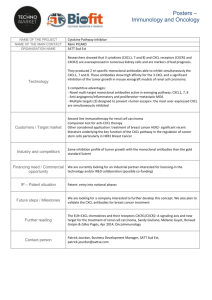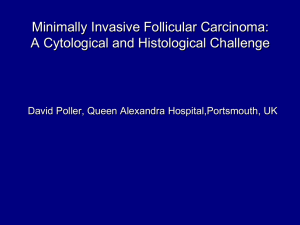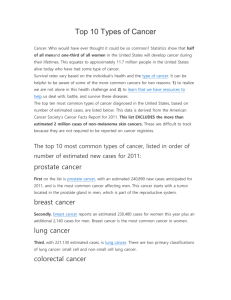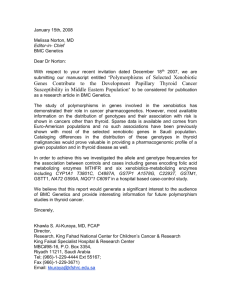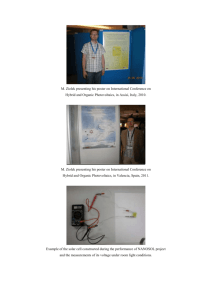Supplementary Information (doc 93K)
advertisement
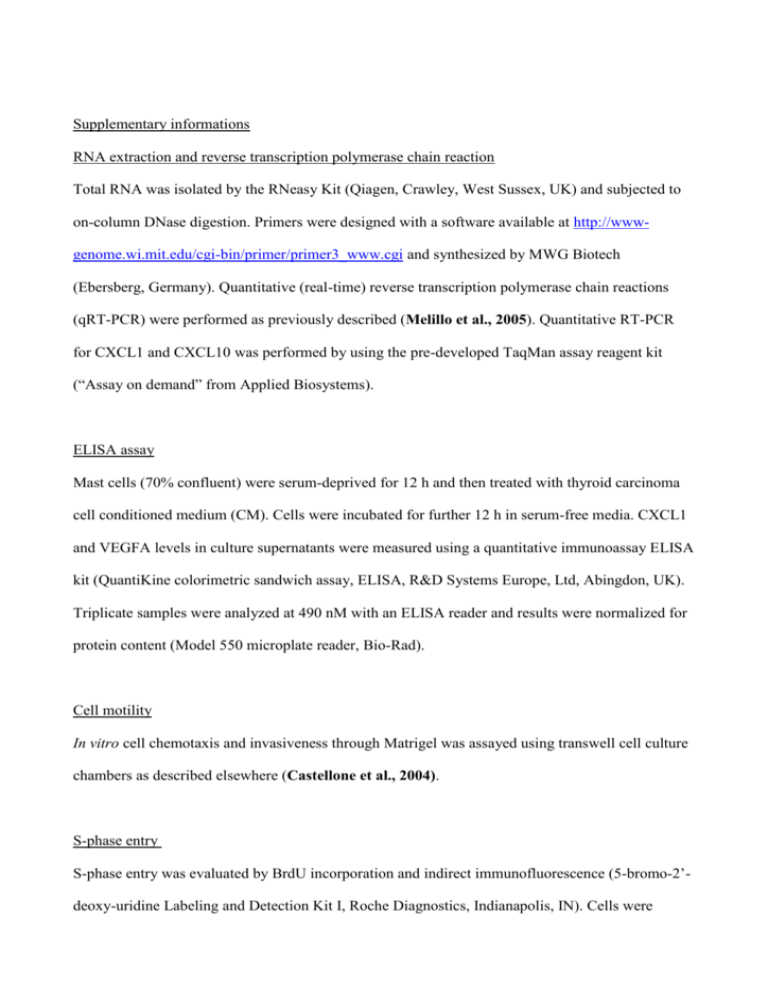
Supplementary informations RNA extraction and reverse transcription polymerase chain reaction Total RNA was isolated by the RNeasy Kit (Qiagen, Crawley, West Sussex, UK) and subjected to on-column DNase digestion. Primers were designed with a software available at http://wwwgenome.wi.mit.edu/cgi-bin/primer/primer3_www.cgi and synthesized by MWG Biotech (Ebersberg, Germany). Quantitative (real-time) reverse transcription polymerase chain reactions (qRT-PCR) were performed as previously described (Melillo et al., 2005). Quantitative RT-PCR for CXCL1 and CXCL10 was performed by using the pre-developed TaqMan assay reagent kit (“Assay on demand” from Applied Biosystems). ELISA assay Mast cells (70% confluent) were serum-deprived for 12 h and then treated with thyroid carcinoma cell conditioned medium (CM). Cells were incubated for further 12 h in serum-free media. CXCL1 and VEGFA levels in culture supernatants were measured using a quantitative immunoassay ELISA kit (QuantiKine colorimetric sandwich assay, ELISA, R&D Systems Europe, Ltd, Abingdon, UK). Triplicate samples were analyzed at 490 nM with an ELISA reader and results were normalized for protein content (Model 550 microplate reader, Bio-Rad). Cell motility In vitro cell chemotaxis and invasiveness through Matrigel was assayed using transwell cell culture chambers as described elsewhere (Castellone et al., 2004). S-phase entry S-phase entry was evaluated by BrdU incorporation and indirect immunofluorescence (5-bromo-2’deoxy-uridine Labeling and Detection Kit I, Roche Diagnostics, Indianapolis, IN). Cells were grown on coverslips, and serum deprived for 12 h. When indicated, thyroid carcinoma cells were treated with mast cell CM, PBL CM, Jurkat CM, CXCL1, CXCL10 (PeproTech, Inc. Rocky Hill, NJ) or histamine (Sigma-Aldrich, St Louis, MO for 48 h. For immunodepletion experiments, HMC1 CM was treated with 1 g/ml CXCL1 (Clone 20326, R&D) or CXCL10 blocking antibodies (Clone 33036, R&D Systems, Minneapolis, MN). BrdU-positive cells were revealed with FITCconjugated secondary antibodies (Jackson Immuno Research Laboratories, Inc., Philadelphia, PA). Cell nuclei were identified by Hoechst 33258 staining (final concentration, 1ug/ml; Sigma-Aldrich). Fluorescence was visualized with a Zeiss 140 epifluorescent microscope. TUNEL assay For terminal desoxynucleotidyl transferase-mediated desoxyuridine triphosphate nick end-labeling (TUNEL), an equal number (5 x 103) of thyroid carcinoma cells was seeded onto single-well Costar glass slides. Cells were serum-deprived for 48 h or treated with HMC-1 or LAD2 CM, fixed in 4% (w/v) paraformaldehyde and permeabilized by the addition of 0.1% Triton X-100/0.1% sodium citrate. Slides were subjected to the TUNEL reaction (Roche) as described elsewhere (Castellone et al., 2004). Purification of peripheral blood lymphocytes (PBL) Human peripheral blood mononuclear cells (PBMC) were purified from human healthy donors. Heparinized blood was centrifuged (300 × g for 30 min) in a gradient of ficoll-hypaque with a density of 1114. Cells were suspended in RPMI 1640 plus 10% FCS and gentamycin (100 μg/ml), and were washed three times in PBS. Cell viability (higher than 98%) was measured by using the Trypan blue exclusion test. The resulting PBMC suspension contains about 10% monocytes and 90% lymphocytes. Adherent cells (nearly pure monocyte culture) were separated from non-adherent cells (nearly pure lymphocytes, PBL). Lymphocyte purity was assessed by FACS analysis with anti-CD3/anti-CD19 antibodies. Histamine release HLMC, LAD2 or HMC-1 cells were grown in complete medium, and serum-deprived for 1 h in DMEM without phenol red. Cells (1x104 mast cell/tube) were suspended in DMEM, placed in 12x75 mm polyethylene tubes and warmed at 370 C; each prewarmed releasing stimulus (TPC1 CM, 8505-C CM, or the Ca++ ionophore A23187, 1 g/ml) was added, and incubation was continued at 370 C for 1 h. The reactions were stopped by centrifugation (1000 x g, 220 C, 2 min), and the cell free supernatants were assayed for histamine content by an histamine ELISA kit (IBL Hamburg, Germany). Supplementary Tables Supplementary Table 1. Clinico-pathological features of normal and papillary thyroid carcinoma (PTC) patients Normal patients FEATURES no. subjects Total (%) 14 (100) Gender male female 4 (29) 10 (71) Age <45y >/=45y 6 (43) 8 (57) PTC patients FEATURES no. subjects Gender male female Age <45y >/=45y Total (%) 96 (100) 21 (22) 75 (78) 51 (53) 45 (47) Histotype PTC-CV PTC-FV PTC-TCV PTC-WLV Capsule invasion yes no Lymph-node metastasis yes no Multifocality yes no Bilateral occurrence yes no Tumor size 0-2 cm 2.1-4 >4 44 (46) 41 (42) 10 (11) 1 (1) 58 (61) 38 (39) 23 (25) 73 (75) 28 (30) 68 (70) 20 (21) 76 (79) 72 (75) 18 (19) 6 (6) Supplementary figure legends Figure S1 Expression of His receptors in human thyroid carcinoma cell lines. A. mRNA levels for H1 and H2 receptors in normal (NT1-NT6) and tumoral (TPC1, NIM, 8505-C, BC-PAP) thyroid cells. Primers were as follows: human H1R, forward 5’accatccaaaacccccaagg-3’; reverse 5’-tcttgaatgcgagcggagcc-3’; human H2R, forward 5’gactctaccgcstgcaag-3’; reverse 5’-gccagtgggtccatgac. For each target, the expression level values of cell lines (y-axis) are calculated relative to the average expression level in the pool of normal human thyroid cultures (NT). All experiments were performed in triplicate, and the average value of the results was plotted on the diagram. SD were smaller than 10% in all the cases (not shown). B. Protein lysates (50 g) extracted from the indicated cell lines underwent western blotting with anti-H1 or –H2 specific antibodies (Santa Cruz). H1 and H2 protein expression was revealed by enhanced chemiluminescence. Equal protein loading was ascertained by anti-tubulin immunoblot (not shown). Figure S2. Histamine (his)-induced BrdU incorporation of TPC1 cells is dependent on H1 and H2 receptors. Both the H1 and H2 antagonists levocitirizine (L, 5 M) and ranitidine (R, 10 M) can inhibit this effect. Figure S3. Enhancement of 8505-C xenografts growth in nude mice in the presence of LAD2 mast cells Xenograft growth was monitored by measuring tumor size weekly. The addition of LAD2 to 8505C cells caused a marked increase in tumor volume. LAD2 alone cells did not form tumors.
